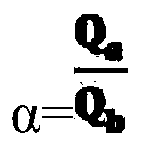A method for preparing ion-imprinted composite membranes by surface thermal polymerization
A technology of ion imprinting and metal ion imprinting, applied in the field of membrane separation, to achieve the effect of simple membrane treatment process, simple preparation process and easy operation
- Summary
- Abstract
- Description
- Claims
- Application Information
AI Technical Summary
Problems solved by technology
Method used
Image
Examples
Embodiment 1
[0035] (1) With the polyvinylidene fluoride microporous flat filter membrane as the base membrane, the polyvinylidene fluoride microporous flat filter membrane is immersed in the acetonitrile solution of the initiator azobisisobutyronitrile with a concentration of 0.03g / ml for 1 hour Then take it out and let it dry naturally to obtain a polymer microporous membrane whose membrane surface is covered with an initiator.
[0036](2) With the heavy metal ion Pb(II) as the template ion, take 1.0mmol of lead nitrate and 2.0mmol of acrylic acid and mix thoroughly, then add 50.0mmol of ethylene glycol dimethacrylate and 0.06mmol of azobisisobutyronitrile, and Mix 20ml of acetonitrile evenly to make a homogeneous solution system, ultrasonically degas, then immerse the polyvinylidene fluoride microporous flat filter membrane covered with an initiator in the solution system, pass through nitrogen gas for 8 minutes, and heat to The reaction was incubated at 55° C. for 24 hours to obtain a ...
Embodiment 2
[0040] (1) take the polypropylene microporous hollow fiber filter membrane as the base membrane, and the polypropylene microporous hollow fiber filter membrane is immersed in the ethanol solution of the initiator azobisisobutyrate of 0.01g / ml in concentration, 4 After one hour, take it out and let it dry naturally to obtain a polymer microporous membrane whose membrane surface is covered with an initiator.
[0041] (2) Take the heavy metal ion Cd(II) as the template ion, take 1.0mmol of cadmium chloride, 4.0mmol of methacrylic acid and mix thoroughly, then add 20.0mmol of trimethoxypropane trimethacrylate and 0.04mmol of azobisiso Dimethyl butyrate was mixed evenly with 18ml ethanol to make a homogeneous solution system, ultrasonically degassed, and then the polypropylene microporous hollow fiber filter membrane covered with an initiator was immersed in the solution system, and nitrogen gas was passed into it for 10min. Heating to 50° C. and insulated reaction for 36 hours und...
Embodiment 3
[0045] (1) Taking the polyacrylonitrile microporous hollow fiber filter membrane as the base membrane, the polyacrylonitrile microporous hollow fiber filter membrane is immersed in the methanol solution of the initiator azobisisoheptanonitrile with a concentration of 0.005g / ml for 2 hours Then take it out and let it dry naturally to obtain a polymer microporous membrane whose membrane surface is covered with an initiator.
[0046] (2) With the heavy metal ion Ni(II) as the template ion, take 1.0mmol of nickel sulfate, 8.0mmol of methyl methacrylate, 20.0mmol of trimethoxypropane trimethacrylate and 10mmol of ethylene glycol dimethacrylate The ester is fully mixed, then add 0.008mmol of azobisisoheptanonitrile, and mix it with 16ml of methanol to make a homogeneous solution system, ultrasonic degassing, and then immerse the polyacrylonitrile microporous hollow fiber filter membrane covered with the initiator The solution system was fed with nitrogen gas for 5 minutes, and heate...
PUM
| Property | Measurement | Unit |
|---|---|---|
| concentration | aaaaa | aaaaa |
Abstract
Description
Claims
Application Information
 Login to View More
Login to View More - R&D
- Intellectual Property
- Life Sciences
- Materials
- Tech Scout
- Unparalleled Data Quality
- Higher Quality Content
- 60% Fewer Hallucinations
Browse by: Latest US Patents, China's latest patents, Technical Efficacy Thesaurus, Application Domain, Technology Topic, Popular Technical Reports.
© 2025 PatSnap. All rights reserved.Legal|Privacy policy|Modern Slavery Act Transparency Statement|Sitemap|About US| Contact US: help@patsnap.com

